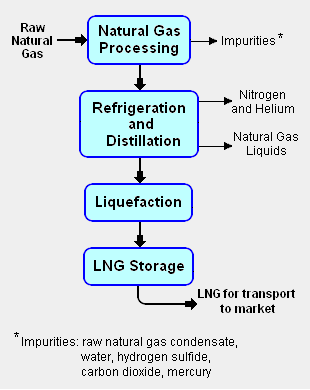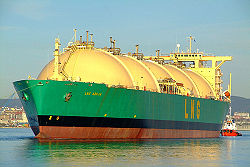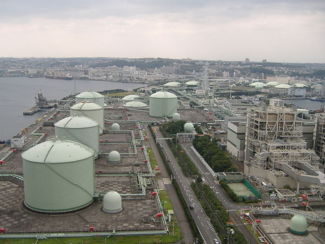User:Milton Beychok/Sandbox
Liquefied natural gas or LNG is natural gas (predominantly methane, CH4) that has been converted into liquid form for ease of transport and storage. More simply put, it is the liquid form of the natural gas that people use in their homes for cooking and for heating,
A typical raw natural gas contains only about 80% methane and a number of higher boiling hydrocarbons as well as a number of impurities. Before it is liquefied, it is typically purified so as to remove the higher-boiling hydrocarbons and the impurities. The resultant liquefied natural gas contains about 95% or more methane and it is a clear, colorless and essentially odorless liquid which is neither corrosive nor toxic.[1][2]
LNG occupies only a very small fraction (1/600th) of the volume of natural gas and is therefore more economical to transport across large distances. It can also be stored in large quantities that would be impractical for storage as a gas.[1][2]
Process description for the production of LNG

Fig.1: Block flow diagram of the LNG liquefaction process. See Natural gas processing for more details.
The liquefaction process involves separating the raw natural gas from any associated water and high-boiling hydrocarbon liquids (referred to as natural gas condensate) that may be associated with the raw gas. The raw gas is then further purified in a natural gas processing plant to remove remove impurities such as the acid gases hydrogen sulfide (H2S) and carbon dioxide (CO2), any residual water liquid or vapor, mercury, nitrogen and helium which could cause difficulty downstream. ( See the block flow diagram of the liquefaction process in Fig.1)
The purified natural gas is next refrigerated and distilled to recover ethane (C2H6), propane (C3H8), butanes (C4H10) and any higher boiling hydrocarbons, collectively referred to as natural gas liquids (NGL). The natural gas is then condensed into a liquid at essentially atmospheric pressure by using further refrigeration to cool it to approximately -162 °C (260 °F).
As mentioned above, the reduction in volume makes LNG much more cost efficient to transport over long distances where pipelines do not exist. Where transporting natural gas by pipelines is not possible or economical, it can be transported by specially designed cryogenic sea-going vessels called LNG carriers or by either cryogenic rail or road tankers.
History
Natural gas liquefaction dates back to the 1820s when British physicist Michael Faraday experimented with liquefying different types of gases. German engineer Carl Von Linde built the first practical vapor-compression refrigeration system in the 1870s.
The first commercial LNG liquefaction plant was built in Cleveland, Ohio, in 1941 and the LNG was stored in tanks at atmospheric pressure, which raised the possibility that LNG could be transported in sea-going vessels. In January 1959, the world's first LNG carrier, a converted freighter named The Methane Pioneer, containing five small, insulated aluminum tanks transported 5,000 m3 (about 2,250 metric tons[3]) of LNG from Lake Charles, Louisiana in the United States to Canvey Island in England's Thames river. That voyage demonstrated that LNG could be transported safely across the oceans. During the next 14 months, that same freighter delivered seven additional cargoes with only a few small problems.[2][4]
The demonstrated ability to transport LNG in sea-going vessels spurred the building of large-scale LNG liquefaction plants at major gas fields world-wide. The first large-scale LNG plant began operating in 1964 at Arzew, Algeria and initially produced about 2,360 metric tons/day (MT/day[3]) of LNG. In 1969, another LNG plant began operating near Kenai, Alaska and initially produced LNG at a rate of about 3,400 MT/day.[2][5]
By mid-2008, there were 19 LNG liquefaction plants operating in 15 countries worldwide. There were also 65 LNG receiving terminals (often referred to regasification terminals) operating in 19 countries world-wide.[5]
LNG transportation
As of 2008, a typical sea-going LNG carrier could transport about 150,000 m3 (70,000 MT) of LNG, which will become about 92,000,000 standard meters[6] natural gas when regasified in a receiving terminal. LNG carriers are similar in its size to an aircraft carrier and are very expensive to build and to operate. Therefore, they cannot afford to have idle time. They travel fast, at an average speed of 18 to 20 knots[7], as compared to 14 knots for a sea-going crude oil carrier. Also, loading at the LNG liquefaction plants and unloading at the receiving terminals usually requires only 15 hours as an average.
Most LNG vessels use steam-turbines to provide propulsion power and those vessels use the gas that boils off from the cargo as fuel for generating steam. Therefore LNG carriers do not arrive at the destination port with the same LNG quantities as were loaded at the liquefaction plant. The accepted maximum figure for boil-off is about 0.15% of cargo volume a day . Thus for a 20 day voyage, the LNG cargo will have been reduced by about 3%. Recent advances in technology allow the installation of plants on-board the vessels that can re-liquefy the boil-off, which is then returned to the cargo tanks. Because of this, the builders and users of LNG carriers can now consider the use of more efficient diesel engines rather than steam-turbines.
LNG Terminals
Some Statistics
Conversion data
References
- ↑ 1.0 1.1 Frequently Asked Questions About LNG From the website of the California Energy Commission
- ↑ 2.0 2.1 2.2 2.3 Introduction To LNG Michelle Michot Foss (January 2007), Center for Energy Economics (CEE), Bureau of Economic Geology, Jackson School of Geosciences, University of Texas
- ↑ 3.0 3.1 Note: 1 metric ton = 1 MT = 1 tonne = 1,000 kg = 2,204.6 pounds = 1.1023 short tons
- ↑ Michael R. Tusiani and Gordon Shearer (2007). LNG: A Nontechnical Guide, p.138. ISBN 0-87814-885-X.
- ↑ 5.0 5.1 Fostering LNG Trade: Role of the Energy Charter 2008, Appendices A and C, from the website of the Energy Charter Secretariat.
- ↑ Note: Presumably , a standard cubic meter of gas is defined as gas at reference conditions of 1 atmosphere pressure and a temperature of about 15 °C. However, most of the LNG literature does not explicitly define the reference conditions.
- ↑ Note: 1 knot = 1 nautical mile/hour = 1.852 km/hour = 1.15 statute mile/hour = 6,076 feet/hour

